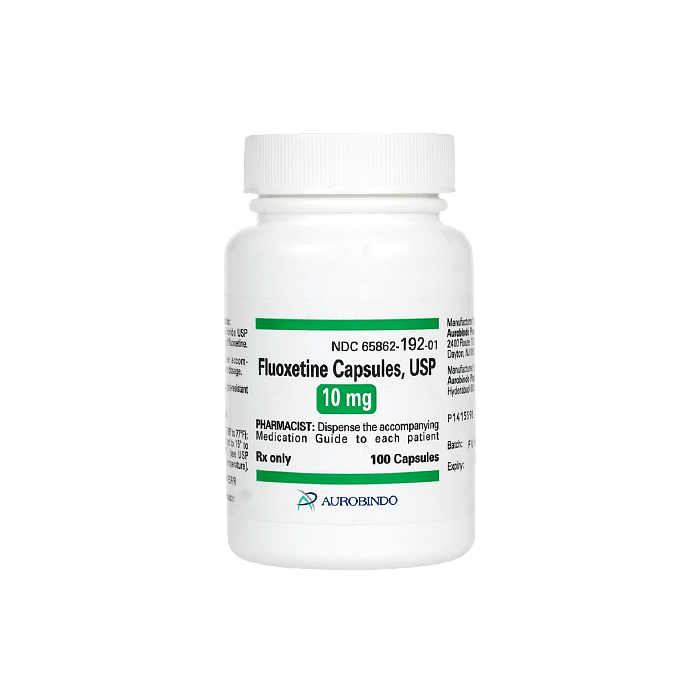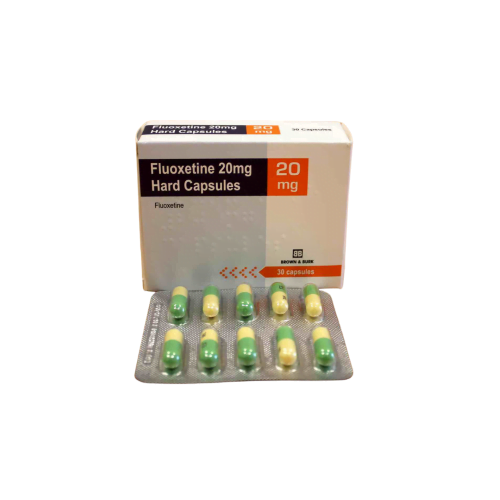Please note: a valid prescription is required for all prescription medication.
Fluoxetine Capsules for Depression
Sitewide Super Sale - Get 15% off when you buy 3 or more of the same product using the code LESS15 at checkout.
Applies to all products originating from Canada. Maximum quantity limited to a 90-day supply per order.
Price range: $73.73 through $73.78
You save


What Fluoxetine Is and How It Works
Fluoxetine is a selective serotonin reuptake inhibitor used for depression, obsessive-compulsive disorder, panic disorder, bulimia nervosa, and premenstrual dysphoric disorder. It helps increase serotonin in the brain, which can improve mood, anxiety, and related symptoms. Ships from Canada to US and may help you compare options without insurance.
Also known by the brand name Prozac®, this medicine has decades of clinical use. It is approved for adults, and some pediatric uses vary by indication. CanadianInsulin.com is a prescription referral platform. We verify prescriptions with your prescriber when required, and licensed Canadian pharmacies dispense your order.
It belongs to the SSRI class. The treatment may take time to show benefit, and consistent daily use is important for effect and safety.
Who It’s For
This therapy is indicated for major depressive disorder in adults and certain adolescents, obsessive-compulsive disorder, panic disorder with or without agoraphobia, bulimia nervosa, and premenstrual dysphoric disorder. A clinician determines suitability based on diagnosis, age, and medical history.
Avoid use with monoamine oxidase inhibitors or within a required washout period. Do not take if you have known hypersensitivity to any component. People with seizure disorders, bipolar disorder, liver disease, or bleeding risks require careful assessment.
Dosage and Usage
Fluoxetine is usually taken once daily, with or without food, at the same time each day. Your prescriber may start at a low dose and adjust gradually. Swallow capsules or tablets whole. The liquid may be measured with a dosing device.
Take as directed by your clinician and the official label. Do not change the dose on your own. If gastrointestinal effects occur, a morning or evening schedule may be suggested. Consistency helps support steady serotonin levels.
Strengths and Forms
This medicine is available as capsules, tablets, and an oral solution. Common capsule strengths span 10–40 mg, and an oral solution is available at 20 mg per 5 mL. Availability can vary by manufacturer and pharmacy.
Generic presentations may include fluoxetine HCl capsules and fluoxetine tablets. Some markets offer brand-name capsules and liquid, as well as authorized generics. Your pharmacist may dispense an equivalent product depending on prescription and stock.
Missed Dose and Timing
If you miss a dose, take it when you remember unless it is close to the next scheduled dose. Skip the missed dose if it is nearly time for the next dose. Do not double up.
Set reminders to support adherence. Ask your clinician or pharmacist if you have questions about timing relative to meals or other medicines.
Storage and Travel Basics
Store capsules, tablets, and oral solution at room temperature, away from excessive heat and moisture, and out of reach of children and pets. Keep the original container tightly closed.
When traveling, bring your prescription label and enough supply for the trip. Pack medicines in carry-on luggage to reduce temperature swings. A written medication list can help at security checkpoints. If you cross borders, carry documentation and a copy of your prescription.
Pen Handling and Sharps Disposal
No pen or injector is used for this treatment. There are no sharps to dispose of for capsules, tablets, or oral solution.
Benefits
As an SSRI, Fluoxetine can reduce depressive symptoms, intrusive thoughts, and panic frequency when taken as prescribed. It may help decrease binge-purge cycles in bulimia nervosa and improve PMDD mood symptoms.
Once-daily dosing is convenient. The long half-life can provide steadier blood levels, which may help with missed doses compared to shorter-acting options.
Side Effects and Safety
- Common: nausea, headache, insomnia or sleepiness, dry mouth, sweating, diarrhea, or anxiety.
- Sexual side effects: lowered libido, delayed ejaculation, or difficulty reaching orgasm.
- Weight change: small increases or decreases may occur.
- Activation: restlessness or jitteriness can happen, especially early on.
Serious risks can include serotonin syndrome, suicidal thoughts and behaviors (especially in young adults and adolescents), angle-closure glaucoma, seizures, abnormal bleeding, SIADH with hyponatremia, and allergic reactions. Seek urgent care if you develop agitation, confusion, fever, muscle rigidity, or severe gastrointestinal symptoms. Alcohol and certain drugs can increase adverse effects.
Drug Interactions and Cautions
Do not combine with MAOIs, linezolid, or IV methylene blue. Use caution with other serotonergic agents such as triptans, SNRIs, other SSRIs, tramadol, lithium, or St. John’s wort due to serotonin syndrome risk. Antiplatelets, NSAIDs, and anticoagulants can increase bleeding risk when used with Fluoxetine.
Fluoxetine inhibits CYP2D6, which can affect tricyclic antidepressants, certain antipsychotics, beta blockers, and some opioids. Strong CYP inducers or inhibitors can alter exposure. Discuss all prescription drugs, over-the-counter products, and supplements with your clinician and pharmacist.
What to Expect Over Time
Some patients notice early changes in sleep or appetite before mood improves. Anxiety or restlessness can appear initially and often settles with continued use. Adherence and regular follow-up support safe progress.
For chronic conditions, long-term maintenance may be recommended after symptom control. Do not stop suddenly; your prescriber will guide any taper plan. If goals are not met, clinicians may adjust the regimen or consider alternatives within the same class.
Compare With Alternatives
Other SSRIs are commonly used for similar conditions. Sertraline is one option that may be considered based on your history; learn more under Zoloft®. Another option is Escitalopram, which is widely prescribed for depression and anxiety disorders.
Choice depends on diagnosis, side effect profile, drug interactions, and prior response. Your clinician will determine the most appropriate therapy.
Pricing and Access
Canadian pricing can offer meaningful savings for eligible orders. You can review options and compare brands, generics, and quantities before checkout. We provide transparent information so you can estimate total costs and plan refills.
Many patients explore savings by looking at generic formulations. If you are seeking value, consider comparing forms and manufacturers. For current offers, see our Promotions. We support US shipping from Canada with prescription verification as required.
Availability and Substitutions
Stock may vary by manufacturer and form. If a requested presentation is unavailable, your prescriber may authorize a therapeutically equivalent substitution. Fluoxetine is provided by multiple generic manufacturers and sometimes an authorized generic of the brand.
Some regions have both capsules and oral solution. Pharmacies will dispense as written or contact your prescriber for alternatives if needed.
Patient Suitability and Cost-Saving Tips
This treatment may suit adults diagnosed with major depressive disorder, OCD, panic disorder, bulimia nervosa, or PMDD. It may not suit those with uncontrolled seizures, severe liver impairment, or recent MAOI use. Older adults and those on anticoagulants require extra caution.
To reduce overall spend, consider multi-month fills when appropriate, and set automated refill reminders so you do not run out. Compare generic options from different manufacturers when offered. Using the same pharmacy can help keep records consistent and improve safety checks.
Questions to Ask Your Clinician
- Right indication: Which diagnosis supports starting Fluoxetine?
- Starting plan: What initial dose and schedule should I follow?
- Interactions: Are any of my medicines risky with this SSRI?
- Side effects: Which effects are most common and how are they managed?
- Monitoring: When should I schedule follow-up to review response?
- Alternatives: If I cannot tolerate this treatment, what are next options?
Authoritative Sources
Review official labeling and safety information before use. For approved indications and comprehensive safety data, see the manufacturer’s resources and government drug databases:
- Prozac (fluoxetine) prescribing information from the manufacturer
- DailyMed: Fluoxetine official label and updates
- Health Canada Drug Product Database: Fluoxetine entry
For related conditions and educational material, you can also explore our condition pages, such as Depression, Anxiety, Obsessive-Compulsive Disorder, Premenstrual Dysphoric Disorder, and Bulimia Nervosa. For a broader perspective, see our article Mental Health And Diabetes, which discusses mental health considerations in people with diabetes.
Order online with encrypted checkout and pharmacy dispensing oversight. For your order, use prompt, express, temperature-controlled handling when required.
Medical disclaimer: This content is for informational purposes only and is not a substitute for professional medical advice.
Express Shipping - from $25.00
Shipping with this method takes 3-5 days
Prices:
- Dry-Packed Products $25.00
- Cold-Packed Products $35.00
Standard Shipping - $15.00
Shipping with this method takes 5-10 days
Prices:
- Dry-Packed Products $15.00
- Not available for Cold-Packed products
What conditions does Fluoxetine treat?
It is approved for major depressive disorder, obsessive-compulsive disorder, panic disorder with or without agoraphobia, bulimia nervosa, and premenstrual dysphoric disorder in appropriate patients.
How should I take Fluoxetine?
Take once daily at the same time, with or without food, exactly as prescribed. Swallow solid forms whole and measure liquid with a dosing device. Do not change your dose without medical guidance.
What are common side effects?
Nausea, headache, insomnia or sleepiness, dry mouth, sweating, diarrhea, nervousness, and sexual side effects may occur. Serious reactions like serotonin syndrome or suicidal thoughts need urgent care.
Can I take Fluoxetine with other medicines?
Discuss all medicines with your clinician. Do not combine with MAOIs or within the required washout period. Use caution with other serotonergic drugs and with anticoagulants or NSAIDs due to bleeding risk.
How long before I notice changes?
Some effects may be noticed earlier than mood changes. Full benefit can take time and varies by person. Keep taking it as prescribed and follow up with your prescriber.
Is alcohol safe with Fluoxetine?
Alcohol can worsen side effects like drowsiness and impaired judgment. Your clinician may recommend limiting or avoiding alcohol while using this SSRI.
Can I stop Fluoxetine abruptly?
Do not stop suddenly. Your prescriber may recommend a gradual taper to reduce the risk of symptom return or withdrawal effects.
Rewards Program
Earn points on birthdays, product orders, reviews, friend referrals, and more! Enjoy your medication at unparalleled discounts while reaping rewards for every step you take with us.
You can read more about rewards here.
POINT VALUE
How to earn points
- 1Create an account and start earning.
- 2Earn points every time you shop or perform certain actions.
- 3Redeem points for exclusive discounts.
You Might Also Like
Related Articles
Zepbound storage: Keep It Safe With Clear Temperature Rules
This guide explains Zepbound storage so your medication stays effective. You will learn temperature limits, how long doses can stay unrefrigerated, travel practices, and what to do if a pen…
Zepbound and Fatigue: Practical Tips to Ease Tiredness Safely
Feeling drained after starting tirzepatide can be unsettling. Many users describe a mix of low energy, mild aches, and disrupted sleep early on. If you are navigating Zepbound and fatigue,…
Mounjaro Heart Benefits Beyond Weight Loss: What Matters
Key Takeaways Beyond weight: Heart-related effects may involve blood sugar, blood pressure, and inflammation. Evidence is evolving: Large outcome trials help clarify real-world heart risk. Heart rate can rise: Small…
Ozempic Rebound: A Practical Guide to Prevent Weight Regain
Many people stop GLP-1 therapy and wonder what comes next. Appetite changes, routine shifts, and metabolism can collide. A clear plan helps you keep progress steady and predictable, not reactive.…


